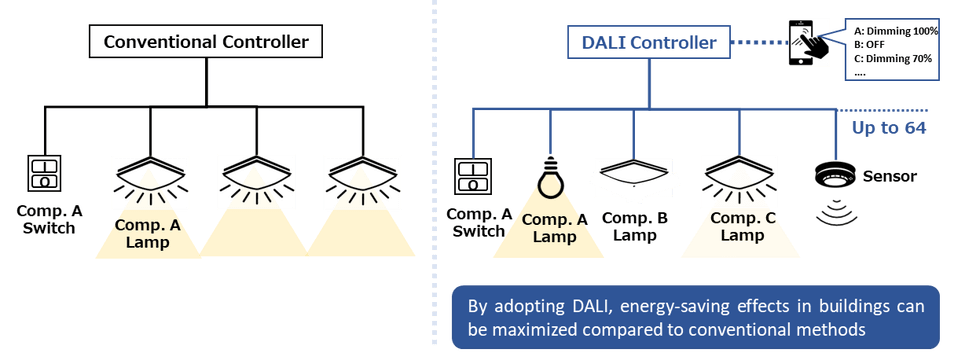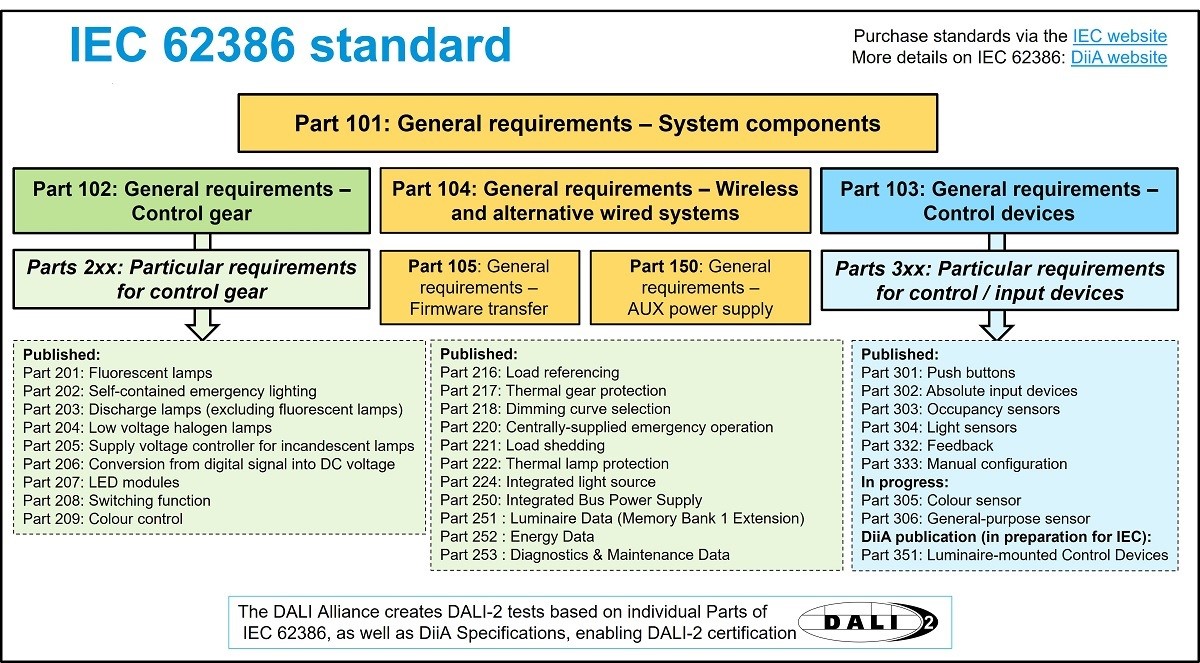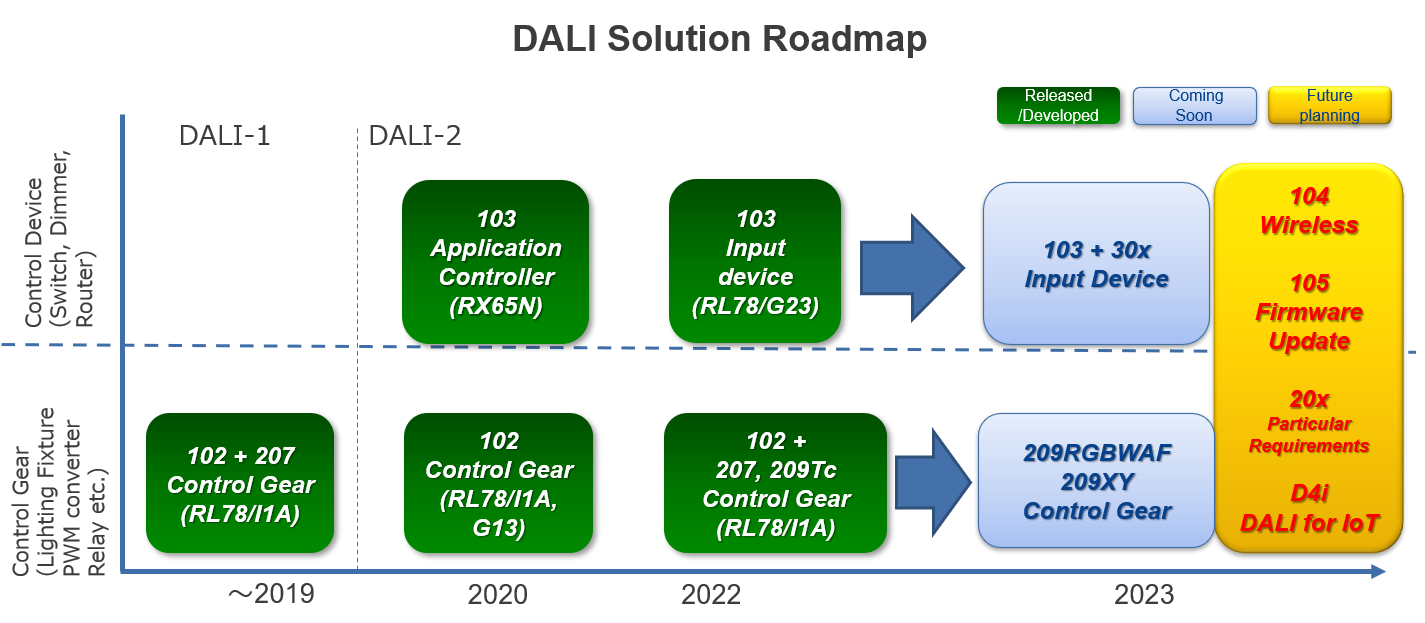What is DALI?
DALI is one of the communication standards for lighting, allowing individual control of each light based on signals from sensors and switches. Let's look at how DALI is superior compared to traditional communication methods.
Traditional Communication Methods
Traditionally, most lighting controls primarily used PWM (Pulse Width Modulation) or analog voltage signals, and group control was the norm. Controlling lighting in a particular area as a whole made it difficult to individually control each lighting fixture (such as lighting fixtures on the window side and the corridor side), posing challenges to the implementation of energy-saving controls that incorporate natural light. Additionally, the control equipment could not receive the status or error information of the lighting equipment, making maintenance cumbersome. While some systems allowed individual control through proprietary methods, communication and control between different manufacturers were impossible. For building owners and design companies choosing lighting fixtures, there was an issue of limited flexibility in lighting products when considering aspects like design and performance.
DALI (Digital Addressable Lighting Interface)
DALI uses digital signals to assign addresses to individual devices, allowing for bidirectional communication between them. This enables not only the individual control of each lighting equipment but also allows the control device to be aware of the state of the lighting equipment. As a result, the state of sensors and lighting equipment can be accurately monitored, allowing for more detailed control. Additionally, since DALI is an open standard, it enables communication and control between products from different manufacturers, expanding the options for building owners and design firms and overcoming the limitations of traditional communication methods.
Thanks to DALI's digital control, it is possible to freely adjust the brightness and color of lighting, significantly contributing to improved energy efficiency and creating comfortable lighting environments. Furthermore, DALI has high interoperability, allowing it to work in conjunction with various input devices such as switches and sensors. This enables even more advanced lighting control and further optimization of a building's lighting environment. For example, it becomes possible to use occupancy sensors to detect the presence or absence of people and only turn on the lights in necessary areas.

The Potential of DALI
DALI is highly regarded as a solution for sustainable societies due to its flexible lighting control and high energy efficiency. In particular, it is considered one of the indispensable technologies for realizing Green Buildings.
By using DALI, lighting within a building can be adjusted to the necessary brightness only when needed. This significantly reduces wasteful electricity consumption and greatly improves energy efficiency. As a result, it helps to reduce the overall CO2 emissions of the building, contributing to the prevention of global warming. Additionally, it is said that lighting control using DALI improves people's comfort and productivity. For example, changing the color of the lighting throughout the day can support people's circadian rhythms, providing a comfortable environment.
Currently, the development of wireless DALI is progressing, and in the future, this will significantly increase the flexibility of installations and eliminate the need for wiring. This reduces the effort required for installation and allows for more freedom in layout design.
As discussed, DALI is a key technology for realizing the Green Buildings of the future. With Renesas' DALI solutions, it becomes possible to implement this excellent DALI communication method simply, easily, and quickly.
Renesas’ DALI Solution
DALI is a digital lighting control interface based on the international standard IEC 62386. IEC 62386 has detailed specification requirements in various parts, each corresponding to different aspects and functions of lighting control. This allows for the operation of the entire lighting system. The industry association known as DiiA¹ plays a significant role in the application and promotion of IEC 62386. Renesas is the first semiconductor manufacturer to become both a member and a regular member of DiiA, and we provide a reliable DALI solution that has been verified with the sole official tester for the protocol stack.
Renesas' DALI-2² Total Solution supports both Control Gear (devices such as lighting fixtures) and Control Devices (master devices like routers). This enables product development that complies with the key parts of IEC 62386. By using Renesas' DALI solution, it is possible to significantly reduce the development time for stacks and applications during product development. Specifically, it is estimated that using this solution can reduce development time by approximately six months to one year.

Source: Standards - Digital Illumination Interface Alliance (dali-alliance.org)
Control Gear and its Appeal
Control Gear plays the role of a slave device in a lighting control system. Specifically, it is a device used for controlling lighting equipment itself, such as LED lights and theatrical lighting.
Renesas' DALI-2 Control Gear employs a library that complies with IEC 62836-102. This enables the adjustment of the operation of lighting equipment and facilitates specific control according to the needs of various lighting environments. It also supports specialized requirements for LED lighting and theatrical lighting, namely 207LED and 209Tc.
Moreover, it utilizes the RL78/I1A microcontroller, which is equipped with DALI communication and peripheral functions for digital power supply. The RL78/I1A incorporates advanced analog features such as a Programmable Gain Amplifier (PGA) and high-speed comparator (CMP), allowing for reductions in CPU load and code size, ultimately leading to a reduction in overall costs. This is an extremely attractive feature for developers who want to create efficient and cost-effective lighting control systems.
Furthermore, to ensure reliability, the stack is tested with the official DALI tester. This ensures that the Control Gear functions as planned, minimizing the possibility of unexpected issues arising.
Control Device and its Appeal
The Control Device plays the role of a master device. In a lighting control system, it primarily sends and receives control signals and operates the lighting devices (Control Gear) as needed.
Renesas' DALI-2 Control Device uses the RL78/G23 microcontroller. This input device supports a noise-resistant Touch function, allowing greater design flexibility compared to mechanical switches and enabling the realization of visually appealing switches. Moreover, by employing the Snooze Mode Sequencer (SMS)³ function for DALI transmission and operation, it reduces CPU load and the number of timers, achieving efficient DALI functionality. This allows users to have a seamless and high-quality lighting control experience.
Additionally, it is compatible with cloud environments through FreeRTOS and the DALI Application Controller Library (compliant with IEC 62386-103). This enables remote management of lighting control. Operations can be performed via three methods: Web (AWS), PC (GUI), and switch, allowing selection according to the situation on-site or user preferences.
Furthermore, it supports user authentication and Over-the-Air (OTA) updates, enhancing security and convenience. Anticipating future expansions, it is also equipped with a DALI driver compatible with proprietary frames of 32-bit and above. This ensures that the system can accommodate the evolving needs of lighting control over the long term.
We are convinced that DALI solutions will play a vital role in future sustainable lighting control systems. To fully utilize its appeal and potential, the integration and interaction of the Control Gear and Control Device are essential. Additionally, Renesas' reliable solutions have the capability to meet the evolving needs of buildings while balancing cost and efficiency. Furthermore, as a regular member of DiiA, Renesas actively participates in the consideration of new standards, continuously develops new stacks (such as wireless), and can keep pace with the latest lighting control requirements. By employing Renesas' DALI solutions, let's take a step toward the realization of sustainable and comfortable buildings for the future.

1. DiiA: Digital Illumination Interface Alliance. An industry consortium aimed at promoting the adoption and development of the DALI lighting communication standard. DiiA develops technical specifications for DALI and implements certification programs for compliant products.
2. DALI-2: An enhanced version of DALI, extending the functionalities of DALI and improving communication reliability and control precision.
3. SMS: Snooze Mode Sequencer. A feature that allows for processing to be executed independently of the CPU.
